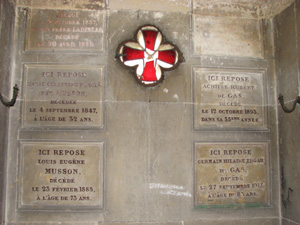
Edgar Germaine-Hilaire De Gas (later contracted to Degas) was born in Paris on July 19, 1834, eldest of five children. His mother, Marie Célestine Musson, was from a French family in New Orleans and died when he was thirteen. Edgar's father, Auguste De Gas, a banker in Paris, urged his son to enter law school. However Edgar did not stay long and was determined to be an artist. He copied the Old Masters
in the Louvre and made regular visits to his grandfather, René-Hilaire Degas, in Naples and his aunt and godmother, Laure Bellelli, in Florence from 1854-59 while studying and copying Renaissance and Ancient Art.
In 1859, Degas had a studio in the Rue Madame, Paris, concentrating on portraiture and historical subjects. From the classical traditional style of painting Degas became aware of the modern life and wanted a change. Degas met Édouard Manet in 1862 and other artists most closely associated with what became known, after 1874, as Impressionism. (The impressionist style of painting is characterized by capturing a momentary glimpse of a scene or object with the use of unmixed primary colors in small strokes to simulate actual reflected light.) 1
Degas’ art began to reflect his change of views when he replaced the traditional, realism of the Old Master themes and captured an impressionistic view of the ordinary life around him. This style and inspirations are reflected in his painting of ballerinas and opera singers in the theatre, jockeys at the racecourse, or the spontaneous gestures of a woman yawning, ironing, holding a hat or women bathing. Unlike Renoir, whose nudes usually shows the face of a beautiful woman, Degas avoided the faces and preferred a back view of the figure – again heightening the illusion of a true-to-life glimpse. Degas was brilliant in capturing trivial events, gestures and movements in his compositions.
From 1865 he continued exhibiting at the Paris Salon until 1870, when he served in the Artillery in the Franco-Prussian War. In 1872 René, his youngest brother, persuaded Edgar, who was beginning to have eye trouble, to accompany him to Louisiana to their uncle Michael Musson’s home in New Orleans. Edgar spent the winter surrounded by his cousins and their children, drawing and painting his family. He made excursions to neighborhood plantations or went to the opera, theater and the racetrack with his relatives.
Edgar was impressed with the happy family life of his brother René and contemplated matrimony himself. In his letters he wrote, “It is something really fine to be married, to have nice children and to be freed of the need for casual affairs. Good heavens, it is time to think about it.” And he informed his friend Rouart: “I am seized with a mania for order. Even a good woman I do not regard as an enemy of this new existence. And would a few children of my own also be too much? No.” “The women here are almost all of them pretty, and to the charms of many of them is added that hint of ugliness without which they would not be perfect. But I fear that their heads are as weak as mine, and two such noodles would be a funny sort of guarantee for a new household.” 2
Edgar left New Orleans in 1873 and gave up the idea of getting married.
In 1874, Edgar Degas exhibited his works in the first Impressionist Exhibition in Paris. By 1877, Degas was forced to sell his work and sacrifice most of his income to help pay the debts of his brother René, who had contributed to most of the loss of the De Gas family fortune and bank in Paris, by poor business decisions. His last public exhibition was in 1886. After this date all Degas’ paintings were shown commercially by Durand-Ruel.
In the last 20 years of his life, Degas’ eyesight deteriorated further and he worked mostly in pastel. In 1890s he could only work on large compositions or sculptures which he could model by touch. In 1908 he more or less gave up art altogether. Depressed, irritable, and falling into terrible silences, Degas only thought of his death.
By 1912 Degas had become famous and his works popular; auctioning for hundreds of thousands of dollars.

September 17, 1917,
Edgar Germaine-Hilaire Degas
died in Paris.
1 www.wikipedia.com
2 Reprinted from John Rewald, “Degas and His Family in New Orleans,” in Gazette des Beaux-Arts, August 1946, Vol. ?, No. ?, page 120.